Employee Relations Report: Strategies for BT Group, Semester 1
VerifiedAdded on 2020/07/23
|16
|5410
|364
Report
AI Summary
This report provides a comprehensive analysis of employee relations within the BT Group, a multinational telecommunications company. It explores the unitary and pluralistic frames of reference, assessing the effects of changes in trade unionism and the roles of key players in employee relationships. The report delves into conflict situations, outlining procedures organizations should follow and evaluating the effectiveness of conflict resolution strategies. Furthermore, it examines the role of negotiation in collective bargaining and assesses the impact of negotiation strategies. The influence of the EU on industrial democracy in the UK is assessed, alongside a comparison of methods for employee participation and an evaluation of human resource management's impact on employee relations. The report concludes with a summary of key findings and recommendations for improving employee relations within the organization.
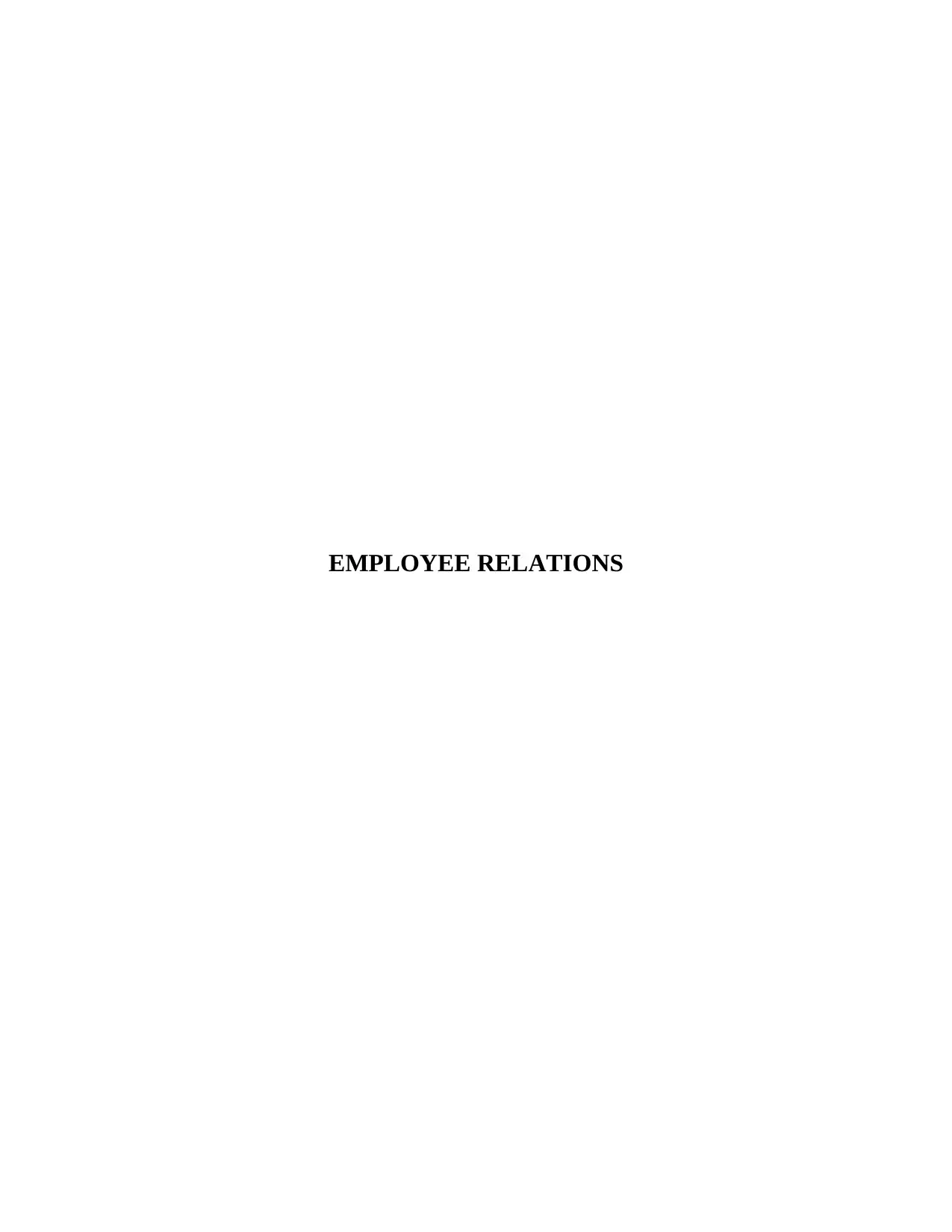
EMPLOYEE RELATIONS
Paraphrase This Document
Need a fresh take? Get an instant paraphrase of this document with our AI Paraphraser
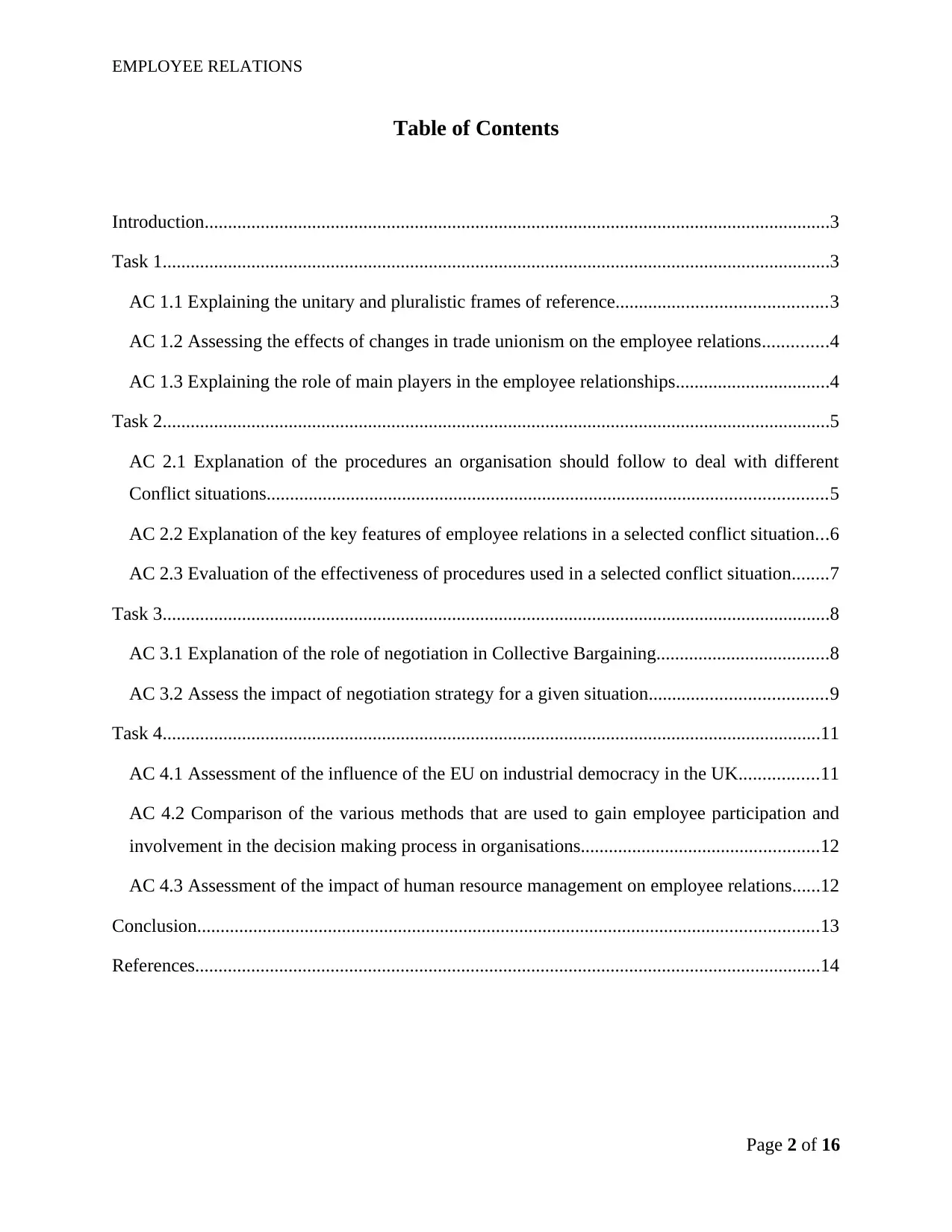
EMPLOYEE RELATIONS
Table of Contents
Introduction......................................................................................................................................3
Task 1...............................................................................................................................................3
AC 1.1 Explaining the unitary and pluralistic frames of reference.............................................3
AC 1.2 Assessing the effects of changes in trade unionism on the employee relations..............4
AC 1.3 Explaining the role of main players in the employee relationships.................................4
Task 2...............................................................................................................................................5
AC 2.1 Explanation of the procedures an organisation should follow to deal with different
Conflict situations........................................................................................................................5
AC 2.2 Explanation of the key features of employee relations in a selected conflict situation...6
AC 2.3 Evaluation of the effectiveness of procedures used in a selected conflict situation........7
Task 3...............................................................................................................................................8
AC 3.1 Explanation of the role of negotiation in Collective Bargaining.....................................8
AC 3.2 Assess the impact of negotiation strategy for a given situation......................................9
Task 4.............................................................................................................................................11
AC 4.1 Assessment of the influence of the EU on industrial democracy in the UK.................11
AC 4.2 Comparison of the various methods that are used to gain employee participation and
involvement in the decision making process in organisations...................................................12
AC 4.3 Assessment of the impact of human resource management on employee relations......12
Conclusion.....................................................................................................................................13
References......................................................................................................................................14
Page 2 of 16
Table of Contents
Introduction......................................................................................................................................3
Task 1...............................................................................................................................................3
AC 1.1 Explaining the unitary and pluralistic frames of reference.............................................3
AC 1.2 Assessing the effects of changes in trade unionism on the employee relations..............4
AC 1.3 Explaining the role of main players in the employee relationships.................................4
Task 2...............................................................................................................................................5
AC 2.1 Explanation of the procedures an organisation should follow to deal with different
Conflict situations........................................................................................................................5
AC 2.2 Explanation of the key features of employee relations in a selected conflict situation...6
AC 2.3 Evaluation of the effectiveness of procedures used in a selected conflict situation........7
Task 3...............................................................................................................................................8
AC 3.1 Explanation of the role of negotiation in Collective Bargaining.....................................8
AC 3.2 Assess the impact of negotiation strategy for a given situation......................................9
Task 4.............................................................................................................................................11
AC 4.1 Assessment of the influence of the EU on industrial democracy in the UK.................11
AC 4.2 Comparison of the various methods that are used to gain employee participation and
involvement in the decision making process in organisations...................................................12
AC 4.3 Assessment of the impact of human resource management on employee relations......12
Conclusion.....................................................................................................................................13
References......................................................................................................................................14
Page 2 of 16
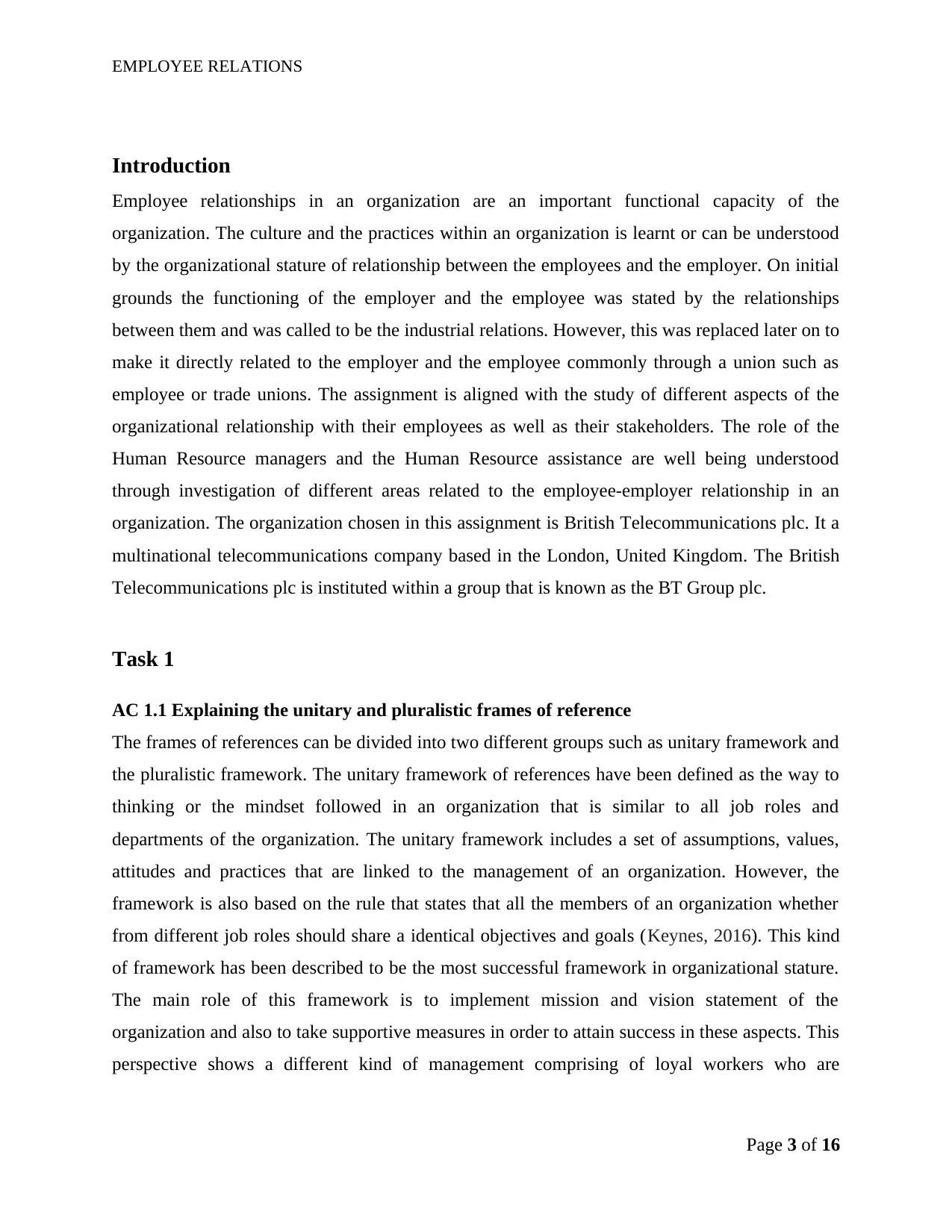
EMPLOYEE RELATIONS
Introduction
Employee relationships in an organization are an important functional capacity of the
organization. The culture and the practices within an organization is learnt or can be understood
by the organizational stature of relationship between the employees and the employer. On initial
grounds the functioning of the employer and the employee was stated by the relationships
between them and was called to be the industrial relations. However, this was replaced later on to
make it directly related to the employer and the employee commonly through a union such as
employee or trade unions. The assignment is aligned with the study of different aspects of the
organizational relationship with their employees as well as their stakeholders. The role of the
Human Resource managers and the Human Resource assistance are well being understood
through investigation of different areas related to the employee-employer relationship in an
organization. The organization chosen in this assignment is British Telecommunications plc. It a
multinational telecommunications company based in the London, United Kingdom. The British
Telecommunications plc is instituted within a group that is known as the BT Group plc.
Task 1
AC 1.1 Explaining the unitary and pluralistic frames of reference
The frames of references can be divided into two different groups such as unitary framework and
the pluralistic framework. The unitary framework of references have been defined as the way to
thinking or the mindset followed in an organization that is similar to all job roles and
departments of the organization. The unitary framework includes a set of assumptions, values,
attitudes and practices that are linked to the management of an organization. However, the
framework is also based on the rule that states that all the members of an organization whether
from different job roles should share a identical objectives and goals (Keynes, 2016). This kind
of framework has been described to be the most successful framework in organizational stature.
The main role of this framework is to implement mission and vision statement of the
organization and also to take supportive measures in order to attain success in these aspects. This
perspective shows a different kind of management comprising of loyal workers who are
Page 3 of 16
Introduction
Employee relationships in an organization are an important functional capacity of the
organization. The culture and the practices within an organization is learnt or can be understood
by the organizational stature of relationship between the employees and the employer. On initial
grounds the functioning of the employer and the employee was stated by the relationships
between them and was called to be the industrial relations. However, this was replaced later on to
make it directly related to the employer and the employee commonly through a union such as
employee or trade unions. The assignment is aligned with the study of different aspects of the
organizational relationship with their employees as well as their stakeholders. The role of the
Human Resource managers and the Human Resource assistance are well being understood
through investigation of different areas related to the employee-employer relationship in an
organization. The organization chosen in this assignment is British Telecommunications plc. It a
multinational telecommunications company based in the London, United Kingdom. The British
Telecommunications plc is instituted within a group that is known as the BT Group plc.
Task 1
AC 1.1 Explaining the unitary and pluralistic frames of reference
The frames of references can be divided into two different groups such as unitary framework and
the pluralistic framework. The unitary framework of references have been defined as the way to
thinking or the mindset followed in an organization that is similar to all job roles and
departments of the organization. The unitary framework includes a set of assumptions, values,
attitudes and practices that are linked to the management of an organization. However, the
framework is also based on the rule that states that all the members of an organization whether
from different job roles should share a identical objectives and goals (Keynes, 2016). This kind
of framework has been described to be the most successful framework in organizational stature.
The main role of this framework is to implement mission and vision statement of the
organization and also to take supportive measures in order to attain success in these aspects. This
perspective shows a different kind of management comprising of loyal workers who are
Page 3 of 16
⊘ This is a preview!⊘
Do you want full access?
Subscribe today to unlock all pages.

Trusted by 1+ million students worldwide
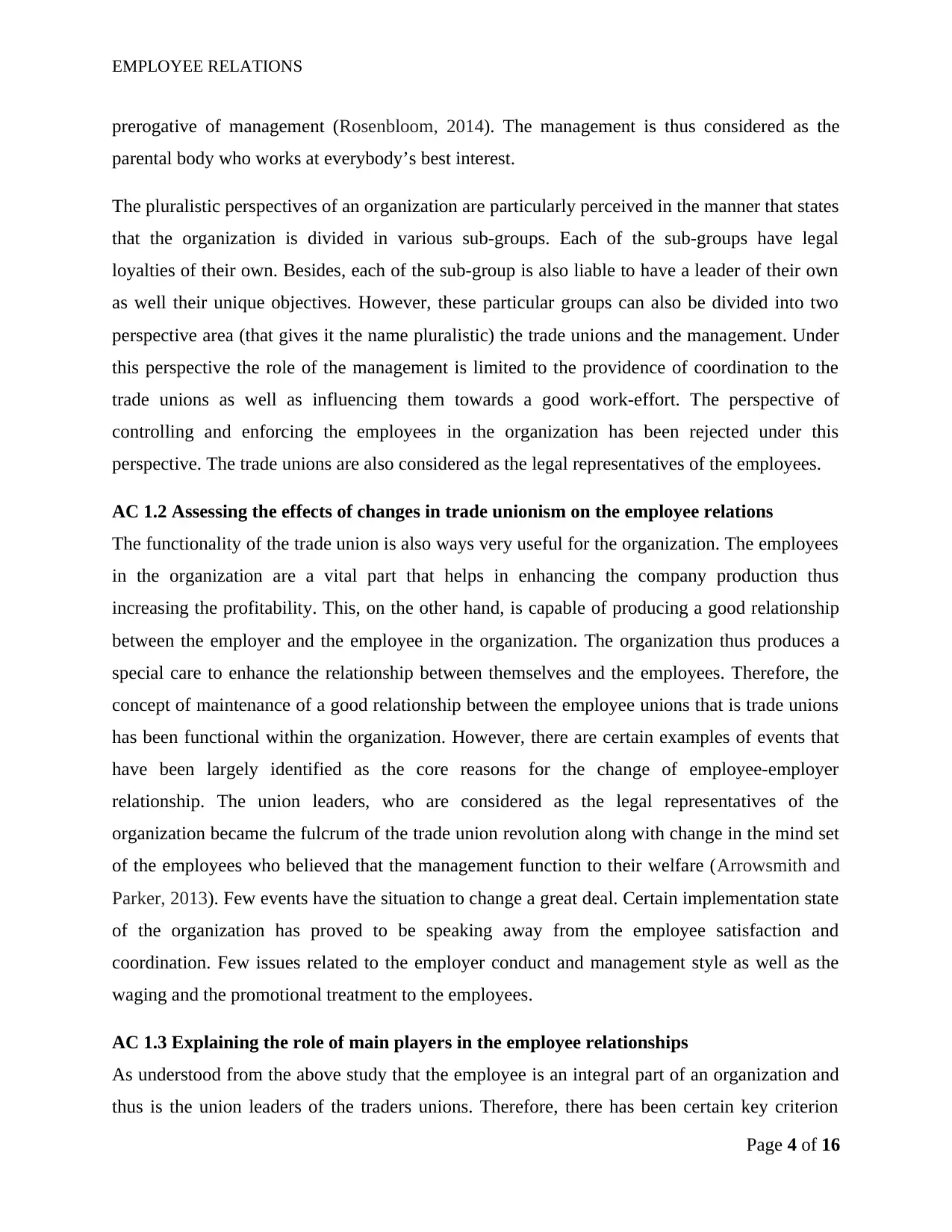
EMPLOYEE RELATIONS
prerogative of management (Rosenbloom, 2014). The management is thus considered as the
parental body who works at everybody’s best interest.
The pluralistic perspectives of an organization are particularly perceived in the manner that states
that the organization is divided in various sub-groups. Each of the sub-groups have legal
loyalties of their own. Besides, each of the sub-group is also liable to have a leader of their own
as well their unique objectives. However, these particular groups can also be divided into two
perspective area (that gives it the name pluralistic) the trade unions and the management. Under
this perspective the role of the management is limited to the providence of coordination to the
trade unions as well as influencing them towards a good work-effort. The perspective of
controlling and enforcing the employees in the organization has been rejected under this
perspective. The trade unions are also considered as the legal representatives of the employees.
AC 1.2 Assessing the effects of changes in trade unionism on the employee relations
The functionality of the trade union is also ways very useful for the organization. The employees
in the organization are a vital part that helps in enhancing the company production thus
increasing the profitability. This, on the other hand, is capable of producing a good relationship
between the employer and the employee in the organization. The organization thus produces a
special care to enhance the relationship between themselves and the employees. Therefore, the
concept of maintenance of a good relationship between the employee unions that is trade unions
has been functional within the organization. However, there are certain examples of events that
have been largely identified as the core reasons for the change of employee-employer
relationship. The union leaders, who are considered as the legal representatives of the
organization became the fulcrum of the trade union revolution along with change in the mind set
of the employees who believed that the management function to their welfare (Arrowsmith and
Parker, 2013). Few events have the situation to change a great deal. Certain implementation state
of the organization has proved to be speaking away from the employee satisfaction and
coordination. Few issues related to the employer conduct and management style as well as the
waging and the promotional treatment to the employees.
AC 1.3 Explaining the role of main players in the employee relationships
As understood from the above study that the employee is an integral part of an organization and
thus is the union leaders of the traders unions. Therefore, there has been certain key criterion
Page 4 of 16
prerogative of management (Rosenbloom, 2014). The management is thus considered as the
parental body who works at everybody’s best interest.
The pluralistic perspectives of an organization are particularly perceived in the manner that states
that the organization is divided in various sub-groups. Each of the sub-groups have legal
loyalties of their own. Besides, each of the sub-group is also liable to have a leader of their own
as well their unique objectives. However, these particular groups can also be divided into two
perspective area (that gives it the name pluralistic) the trade unions and the management. Under
this perspective the role of the management is limited to the providence of coordination to the
trade unions as well as influencing them towards a good work-effort. The perspective of
controlling and enforcing the employees in the organization has been rejected under this
perspective. The trade unions are also considered as the legal representatives of the employees.
AC 1.2 Assessing the effects of changes in trade unionism on the employee relations
The functionality of the trade union is also ways very useful for the organization. The employees
in the organization are a vital part that helps in enhancing the company production thus
increasing the profitability. This, on the other hand, is capable of producing a good relationship
between the employer and the employee in the organization. The organization thus produces a
special care to enhance the relationship between themselves and the employees. Therefore, the
concept of maintenance of a good relationship between the employee unions that is trade unions
has been functional within the organization. However, there are certain examples of events that
have been largely identified as the core reasons for the change of employee-employer
relationship. The union leaders, who are considered as the legal representatives of the
organization became the fulcrum of the trade union revolution along with change in the mind set
of the employees who believed that the management function to their welfare (Arrowsmith and
Parker, 2013). Few events have the situation to change a great deal. Certain implementation state
of the organization has proved to be speaking away from the employee satisfaction and
coordination. Few issues related to the employer conduct and management style as well as the
waging and the promotional treatment to the employees.
AC 1.3 Explaining the role of main players in the employee relationships
As understood from the above study that the employee is an integral part of an organization and
thus is the union leaders of the traders unions. Therefore, there has been certain key criterion
Page 4 of 16
Paraphrase This Document
Need a fresh take? Get an instant paraphrase of this document with our AI Paraphraser
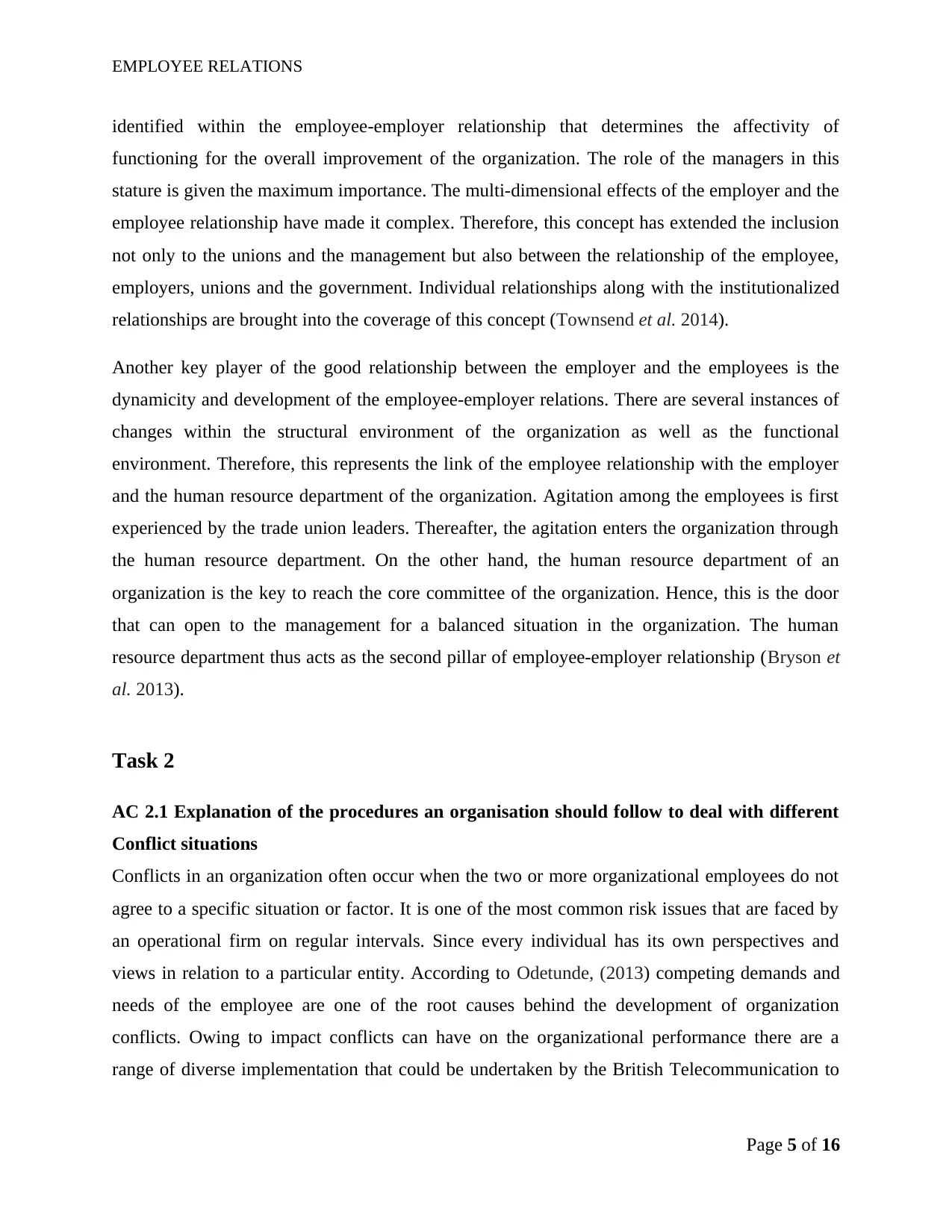
EMPLOYEE RELATIONS
identified within the employee-employer relationship that determines the affectivity of
functioning for the overall improvement of the organization. The role of the managers in this
stature is given the maximum importance. The multi-dimensional effects of the employer and the
employee relationship have made it complex. Therefore, this concept has extended the inclusion
not only to the unions and the management but also between the relationship of the employee,
employers, unions and the government. Individual relationships along with the institutionalized
relationships are brought into the coverage of this concept (Townsend et al. 2014).
Another key player of the good relationship between the employer and the employees is the
dynamicity and development of the employee-employer relations. There are several instances of
changes within the structural environment of the organization as well as the functional
environment. Therefore, this represents the link of the employee relationship with the employer
and the human resource department of the organization. Agitation among the employees is first
experienced by the trade union leaders. Thereafter, the agitation enters the organization through
the human resource department. On the other hand, the human resource department of an
organization is the key to reach the core committee of the organization. Hence, this is the door
that can open to the management for a balanced situation in the organization. The human
resource department thus acts as the second pillar of employee-employer relationship (Bryson et
al. 2013).
Task 2
AC 2.1 Explanation of the procedures an organisation should follow to deal with different
Conflict situations
Conflicts in an organization often occur when the two or more organizational employees do not
agree to a specific situation or factor. It is one of the most common risk issues that are faced by
an operational firm on regular intervals. Since every individual has its own perspectives and
views in relation to a particular entity. According to Odetunde, (2013) competing demands and
needs of the employee are one of the root causes behind the development of organization
conflicts. Owing to impact conflicts can have on the organizational performance there are a
range of diverse implementation that could be undertaken by the British Telecommunication to
Page 5 of 16
identified within the employee-employer relationship that determines the affectivity of
functioning for the overall improvement of the organization. The role of the managers in this
stature is given the maximum importance. The multi-dimensional effects of the employer and the
employee relationship have made it complex. Therefore, this concept has extended the inclusion
not only to the unions and the management but also between the relationship of the employee,
employers, unions and the government. Individual relationships along with the institutionalized
relationships are brought into the coverage of this concept (Townsend et al. 2014).
Another key player of the good relationship between the employer and the employees is the
dynamicity and development of the employee-employer relations. There are several instances of
changes within the structural environment of the organization as well as the functional
environment. Therefore, this represents the link of the employee relationship with the employer
and the human resource department of the organization. Agitation among the employees is first
experienced by the trade union leaders. Thereafter, the agitation enters the organization through
the human resource department. On the other hand, the human resource department of an
organization is the key to reach the core committee of the organization. Hence, this is the door
that can open to the management for a balanced situation in the organization. The human
resource department thus acts as the second pillar of employee-employer relationship (Bryson et
al. 2013).
Task 2
AC 2.1 Explanation of the procedures an organisation should follow to deal with different
Conflict situations
Conflicts in an organization often occur when the two or more organizational employees do not
agree to a specific situation or factor. It is one of the most common risk issues that are faced by
an operational firm on regular intervals. Since every individual has its own perspectives and
views in relation to a particular entity. According to Odetunde, (2013) competing demands and
needs of the employee are one of the root causes behind the development of organization
conflicts. Owing to impact conflicts can have on the organizational performance there are a
range of diverse implementation that could be undertaken by the British Telecommunication to
Page 5 of 16
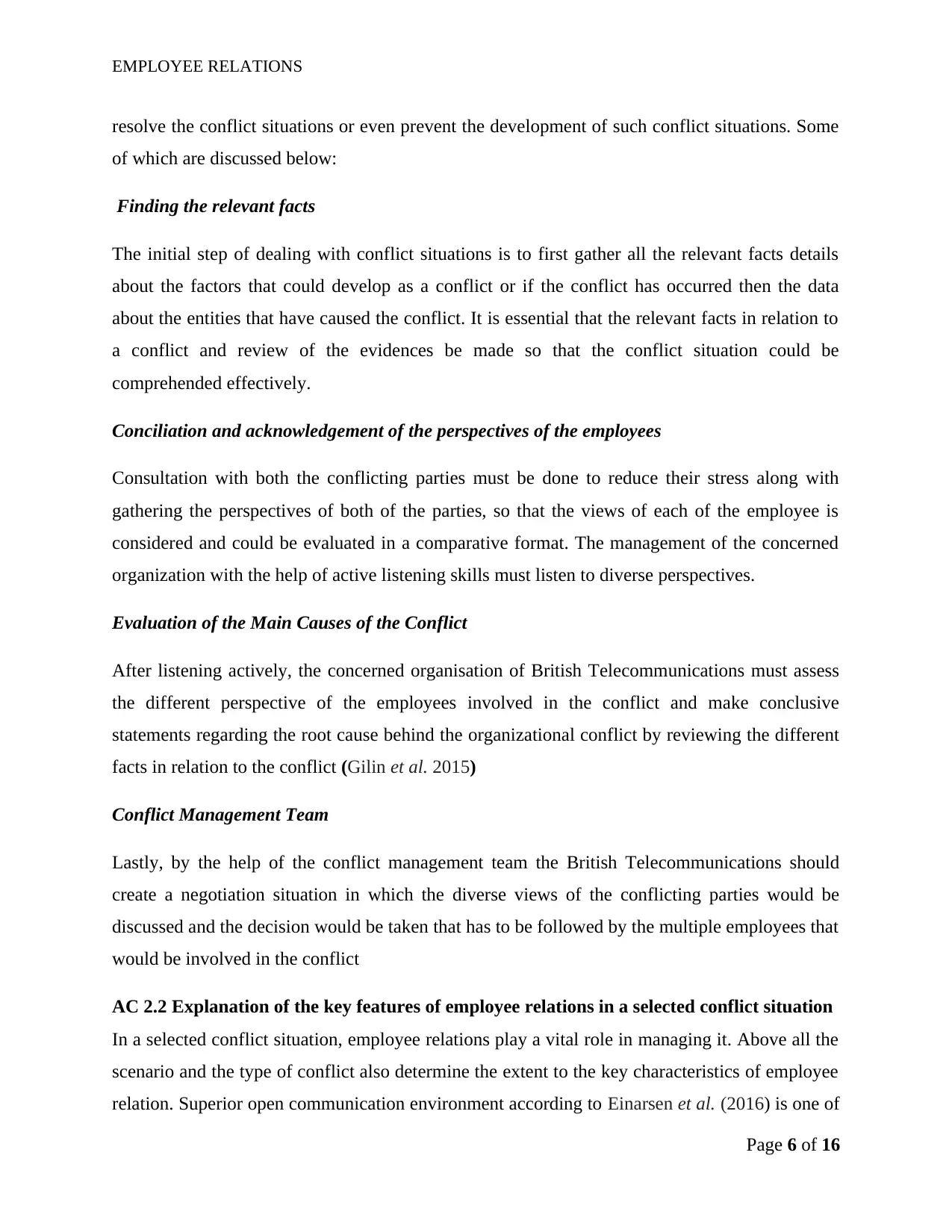
EMPLOYEE RELATIONS
resolve the conflict situations or even prevent the development of such conflict situations. Some
of which are discussed below:
Finding the relevant facts
The initial step of dealing with conflict situations is to first gather all the relevant facts details
about the factors that could develop as a conflict or if the conflict has occurred then the data
about the entities that have caused the conflict. It is essential that the relevant facts in relation to
a conflict and review of the evidences be made so that the conflict situation could be
comprehended effectively.
Conciliation and acknowledgement of the perspectives of the employees
Consultation with both the conflicting parties must be done to reduce their stress along with
gathering the perspectives of both of the parties, so that the views of each of the employee is
considered and could be evaluated in a comparative format. The management of the concerned
organization with the help of active listening skills must listen to diverse perspectives.
Evaluation of the Main Causes of the Conflict
After listening actively, the concerned organisation of British Telecommunications must assess
the different perspective of the employees involved in the conflict and make conclusive
statements regarding the root cause behind the organizational conflict by reviewing the different
facts in relation to the conflict (Gilin et al. 2015)
Conflict Management Team
Lastly, by the help of the conflict management team the British Telecommunications should
create a negotiation situation in which the diverse views of the conflicting parties would be
discussed and the decision would be taken that has to be followed by the multiple employees that
would be involved in the conflict
AC 2.2 Explanation of the key features of employee relations in a selected conflict situation
In a selected conflict situation, employee relations play a vital role in managing it. Above all the
scenario and the type of conflict also determine the extent to the key characteristics of employee
relation. Superior open communication environment according to Einarsen et al. (2016) is one of
Page 6 of 16
resolve the conflict situations or even prevent the development of such conflict situations. Some
of which are discussed below:
Finding the relevant facts
The initial step of dealing with conflict situations is to first gather all the relevant facts details
about the factors that could develop as a conflict or if the conflict has occurred then the data
about the entities that have caused the conflict. It is essential that the relevant facts in relation to
a conflict and review of the evidences be made so that the conflict situation could be
comprehended effectively.
Conciliation and acknowledgement of the perspectives of the employees
Consultation with both the conflicting parties must be done to reduce their stress along with
gathering the perspectives of both of the parties, so that the views of each of the employee is
considered and could be evaluated in a comparative format. The management of the concerned
organization with the help of active listening skills must listen to diverse perspectives.
Evaluation of the Main Causes of the Conflict
After listening actively, the concerned organisation of British Telecommunications must assess
the different perspective of the employees involved in the conflict and make conclusive
statements regarding the root cause behind the organizational conflict by reviewing the different
facts in relation to the conflict (Gilin et al. 2015)
Conflict Management Team
Lastly, by the help of the conflict management team the British Telecommunications should
create a negotiation situation in which the diverse views of the conflicting parties would be
discussed and the decision would be taken that has to be followed by the multiple employees that
would be involved in the conflict
AC 2.2 Explanation of the key features of employee relations in a selected conflict situation
In a selected conflict situation, employee relations play a vital role in managing it. Above all the
scenario and the type of conflict also determine the extent to the key characteristics of employee
relation. Superior open communication environment according to Einarsen et al. (2016) is one of
Page 6 of 16
⊘ This is a preview!⊘
Do you want full access?
Subscribe today to unlock all pages.

Trusted by 1+ million students worldwide
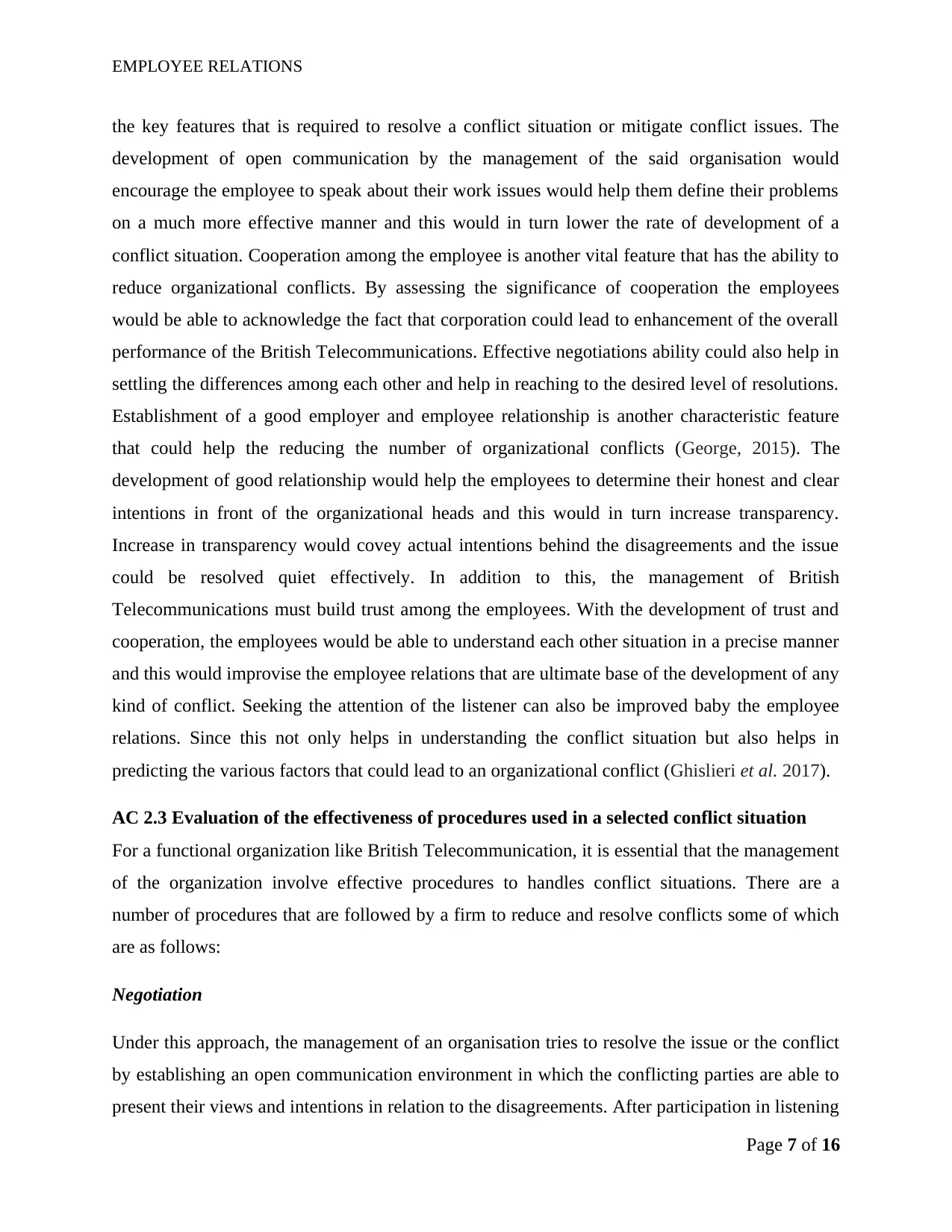
EMPLOYEE RELATIONS
the key features that is required to resolve a conflict situation or mitigate conflict issues. The
development of open communication by the management of the said organisation would
encourage the employee to speak about their work issues would help them define their problems
on a much more effective manner and this would in turn lower the rate of development of a
conflict situation. Cooperation among the employee is another vital feature that has the ability to
reduce organizational conflicts. By assessing the significance of cooperation the employees
would be able to acknowledge the fact that corporation could lead to enhancement of the overall
performance of the British Telecommunications. Effective negotiations ability could also help in
settling the differences among each other and help in reaching to the desired level of resolutions.
Establishment of a good employer and employee relationship is another characteristic feature
that could help the reducing the number of organizational conflicts (George, 2015). The
development of good relationship would help the employees to determine their honest and clear
intentions in front of the organizational heads and this would in turn increase transparency.
Increase in transparency would covey actual intentions behind the disagreements and the issue
could be resolved quiet effectively. In addition to this, the management of British
Telecommunications must build trust among the employees. With the development of trust and
cooperation, the employees would be able to understand each other situation in a precise manner
and this would improvise the employee relations that are ultimate base of the development of any
kind of conflict. Seeking the attention of the listener can also be improved baby the employee
relations. Since this not only helps in understanding the conflict situation but also helps in
predicting the various factors that could lead to an organizational conflict (Ghislieri et al. 2017).
AC 2.3 Evaluation of the effectiveness of procedures used in a selected conflict situation
For a functional organization like British Telecommunication, it is essential that the management
of the organization involve effective procedures to handles conflict situations. There are a
number of procedures that are followed by a firm to reduce and resolve conflicts some of which
are as follows:
Negotiation
Under this approach, the management of an organisation tries to resolve the issue or the conflict
by establishing an open communication environment in which the conflicting parties are able to
present their views and intentions in relation to the disagreements. After participation in listening
Page 7 of 16
the key features that is required to resolve a conflict situation or mitigate conflict issues. The
development of open communication by the management of the said organisation would
encourage the employee to speak about their work issues would help them define their problems
on a much more effective manner and this would in turn lower the rate of development of a
conflict situation. Cooperation among the employee is another vital feature that has the ability to
reduce organizational conflicts. By assessing the significance of cooperation the employees
would be able to acknowledge the fact that corporation could lead to enhancement of the overall
performance of the British Telecommunications. Effective negotiations ability could also help in
settling the differences among each other and help in reaching to the desired level of resolutions.
Establishment of a good employer and employee relationship is another characteristic feature
that could help the reducing the number of organizational conflicts (George, 2015). The
development of good relationship would help the employees to determine their honest and clear
intentions in front of the organizational heads and this would in turn increase transparency.
Increase in transparency would covey actual intentions behind the disagreements and the issue
could be resolved quiet effectively. In addition to this, the management of British
Telecommunications must build trust among the employees. With the development of trust and
cooperation, the employees would be able to understand each other situation in a precise manner
and this would improvise the employee relations that are ultimate base of the development of any
kind of conflict. Seeking the attention of the listener can also be improved baby the employee
relations. Since this not only helps in understanding the conflict situation but also helps in
predicting the various factors that could lead to an organizational conflict (Ghislieri et al. 2017).
AC 2.3 Evaluation of the effectiveness of procedures used in a selected conflict situation
For a functional organization like British Telecommunication, it is essential that the management
of the organization involve effective procedures to handles conflict situations. There are a
number of procedures that are followed by a firm to reduce and resolve conflicts some of which
are as follows:
Negotiation
Under this approach, the management of an organisation tries to resolve the issue or the conflict
by establishing an open communication environment in which the conflicting parties are able to
present their views and intentions in relation to the disagreements. After participation in listening
Page 7 of 16
Paraphrase This Document
Need a fresh take? Get an instant paraphrase of this document with our AI Paraphraser
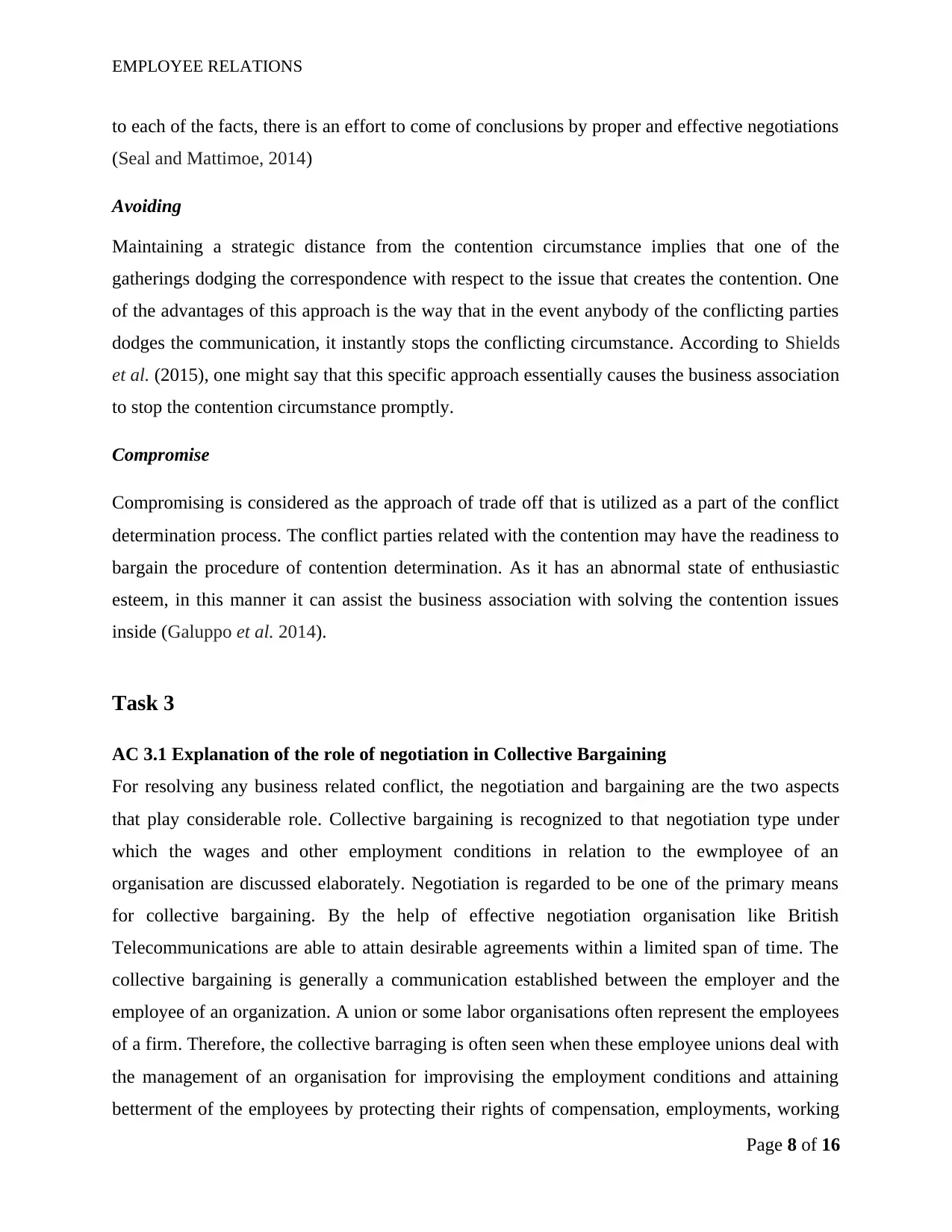
EMPLOYEE RELATIONS
to each of the facts, there is an effort to come of conclusions by proper and effective negotiations
(Seal and Mattimoe, 2014)
Avoiding
Maintaining a strategic distance from the contention circumstance implies that one of the
gatherings dodging the correspondence with respect to the issue that creates the contention. One
of the advantages of this approach is the way that in the event anybody of the conflicting parties
dodges the communication, it instantly stops the conflicting circumstance. According to Shields
et al. (2015), one might say that this specific approach essentially causes the business association
to stop the contention circumstance promptly.
Compromise
Compromising is considered as the approach of trade off that is utilized as a part of the conflict
determination process. The conflict parties related with the contention may have the readiness to
bargain the procedure of contention determination. As it has an abnormal state of enthusiastic
esteem, in this manner it can assist the business association with solving the contention issues
inside (Galuppo et al. 2014).
Task 3
AC 3.1 Explanation of the role of negotiation in Collective Bargaining
For resolving any business related conflict, the negotiation and bargaining are the two aspects
that play considerable role. Collective bargaining is recognized to that negotiation type under
which the wages and other employment conditions in relation to the ewmployee of an
organisation are discussed elaborately. Negotiation is regarded to be one of the primary means
for collective bargaining. By the help of effective negotiation organisation like British
Telecommunications are able to attain desirable agreements within a limited span of time. The
collective bargaining is generally a communication established between the employer and the
employee of an organization. A union or some labor organisations often represent the employees
of a firm. Therefore, the collective barraging is often seen when these employee unions deal with
the management of an organisation for improvising the employment conditions and attaining
betterment of the employees by protecting their rights of compensation, employments, working
Page 8 of 16
to each of the facts, there is an effort to come of conclusions by proper and effective negotiations
(Seal and Mattimoe, 2014)
Avoiding
Maintaining a strategic distance from the contention circumstance implies that one of the
gatherings dodging the correspondence with respect to the issue that creates the contention. One
of the advantages of this approach is the way that in the event anybody of the conflicting parties
dodges the communication, it instantly stops the conflicting circumstance. According to Shields
et al. (2015), one might say that this specific approach essentially causes the business association
to stop the contention circumstance promptly.
Compromise
Compromising is considered as the approach of trade off that is utilized as a part of the conflict
determination process. The conflict parties related with the contention may have the readiness to
bargain the procedure of contention determination. As it has an abnormal state of enthusiastic
esteem, in this manner it can assist the business association with solving the contention issues
inside (Galuppo et al. 2014).
Task 3
AC 3.1 Explanation of the role of negotiation in Collective Bargaining
For resolving any business related conflict, the negotiation and bargaining are the two aspects
that play considerable role. Collective bargaining is recognized to that negotiation type under
which the wages and other employment conditions in relation to the ewmployee of an
organisation are discussed elaborately. Negotiation is regarded to be one of the primary means
for collective bargaining. By the help of effective negotiation organisation like British
Telecommunications are able to attain desirable agreements within a limited span of time. The
collective bargaining is generally a communication established between the employer and the
employee of an organization. A union or some labor organisations often represent the employees
of a firm. Therefore, the collective barraging is often seen when these employee unions deal with
the management of an organisation for improvising the employment conditions and attaining
betterment of the employees by protecting their rights of compensation, employments, working
Page 8 of 16
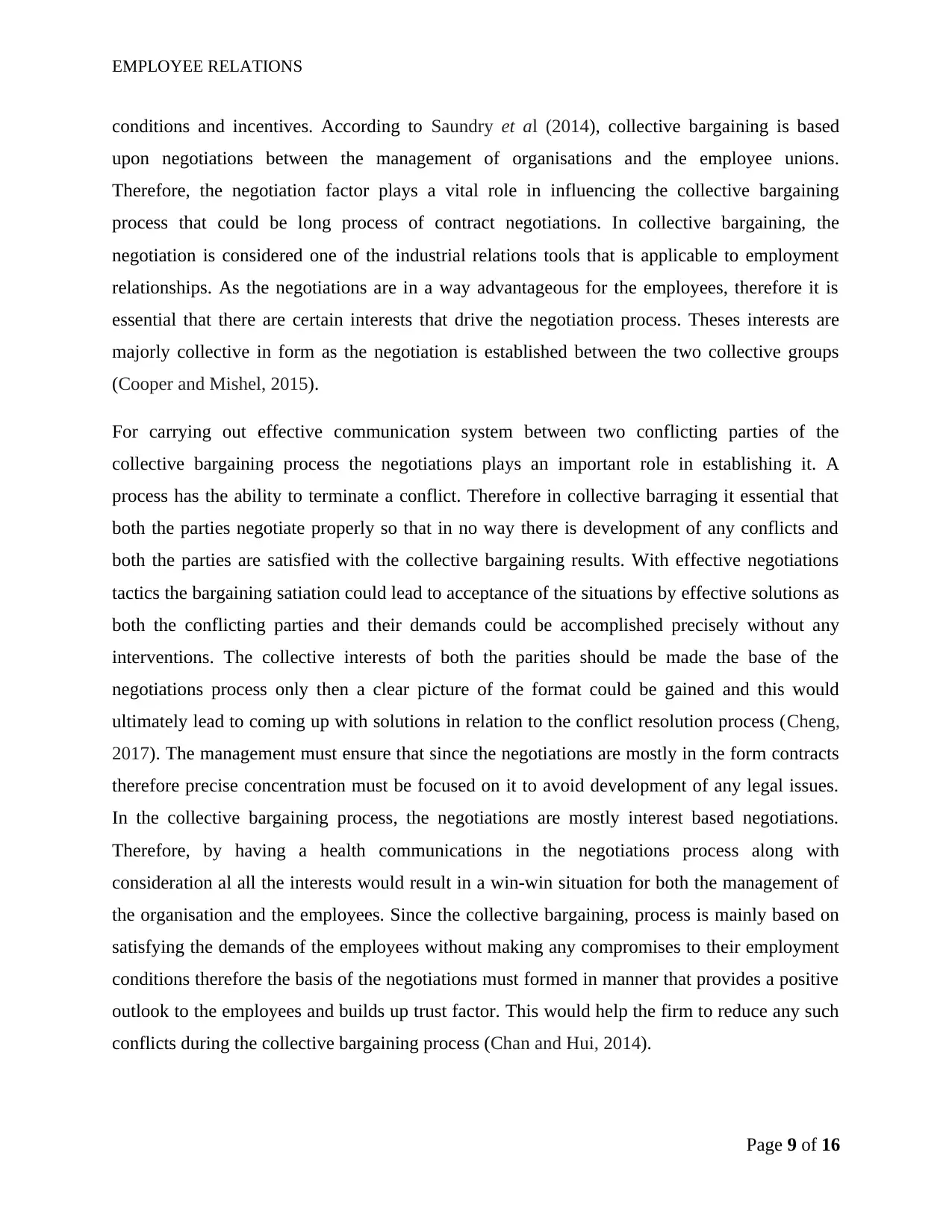
EMPLOYEE RELATIONS
conditions and incentives. According to Saundry et al (2014), collective bargaining is based
upon negotiations between the management of organisations and the employee unions.
Therefore, the negotiation factor plays a vital role in influencing the collective bargaining
process that could be long process of contract negotiations. In collective bargaining, the
negotiation is considered one of the industrial relations tools that is applicable to employment
relationships. As the negotiations are in a way advantageous for the employees, therefore it is
essential that there are certain interests that drive the negotiation process. Theses interests are
majorly collective in form as the negotiation is established between the two collective groups
(Cooper and Mishel, 2015).
For carrying out effective communication system between two conflicting parties of the
collective bargaining process the negotiations plays an important role in establishing it. A
process has the ability to terminate a conflict. Therefore in collective barraging it essential that
both the parties negotiate properly so that in no way there is development of any conflicts and
both the parties are satisfied with the collective bargaining results. With effective negotiations
tactics the bargaining satiation could lead to acceptance of the situations by effective solutions as
both the conflicting parties and their demands could be accomplished precisely without any
interventions. The collective interests of both the parities should be made the base of the
negotiations process only then a clear picture of the format could be gained and this would
ultimately lead to coming up with solutions in relation to the conflict resolution process (Cheng,
2017). The management must ensure that since the negotiations are mostly in the form contracts
therefore precise concentration must be focused on it to avoid development of any legal issues.
In the collective bargaining process, the negotiations are mostly interest based negotiations.
Therefore, by having a health communications in the negotiations process along with
consideration al all the interests would result in a win-win situation for both the management of
the organisation and the employees. Since the collective bargaining, process is mainly based on
satisfying the demands of the employees without making any compromises to their employment
conditions therefore the basis of the negotiations must formed in manner that provides a positive
outlook to the employees and builds up trust factor. This would help the firm to reduce any such
conflicts during the collective bargaining process (Chan and Hui, 2014).
Page 9 of 16
conditions and incentives. According to Saundry et al (2014), collective bargaining is based
upon negotiations between the management of organisations and the employee unions.
Therefore, the negotiation factor plays a vital role in influencing the collective bargaining
process that could be long process of contract negotiations. In collective bargaining, the
negotiation is considered one of the industrial relations tools that is applicable to employment
relationships. As the negotiations are in a way advantageous for the employees, therefore it is
essential that there are certain interests that drive the negotiation process. Theses interests are
majorly collective in form as the negotiation is established between the two collective groups
(Cooper and Mishel, 2015).
For carrying out effective communication system between two conflicting parties of the
collective bargaining process the negotiations plays an important role in establishing it. A
process has the ability to terminate a conflict. Therefore in collective barraging it essential that
both the parties negotiate properly so that in no way there is development of any conflicts and
both the parties are satisfied with the collective bargaining results. With effective negotiations
tactics the bargaining satiation could lead to acceptance of the situations by effective solutions as
both the conflicting parties and their demands could be accomplished precisely without any
interventions. The collective interests of both the parities should be made the base of the
negotiations process only then a clear picture of the format could be gained and this would
ultimately lead to coming up with solutions in relation to the conflict resolution process (Cheng,
2017). The management must ensure that since the negotiations are mostly in the form contracts
therefore precise concentration must be focused on it to avoid development of any legal issues.
In the collective bargaining process, the negotiations are mostly interest based negotiations.
Therefore, by having a health communications in the negotiations process along with
consideration al all the interests would result in a win-win situation for both the management of
the organisation and the employees. Since the collective bargaining, process is mainly based on
satisfying the demands of the employees without making any compromises to their employment
conditions therefore the basis of the negotiations must formed in manner that provides a positive
outlook to the employees and builds up trust factor. This would help the firm to reduce any such
conflicts during the collective bargaining process (Chan and Hui, 2014).
Page 9 of 16
⊘ This is a preview!⊘
Do you want full access?
Subscribe today to unlock all pages.

Trusted by 1+ million students worldwide
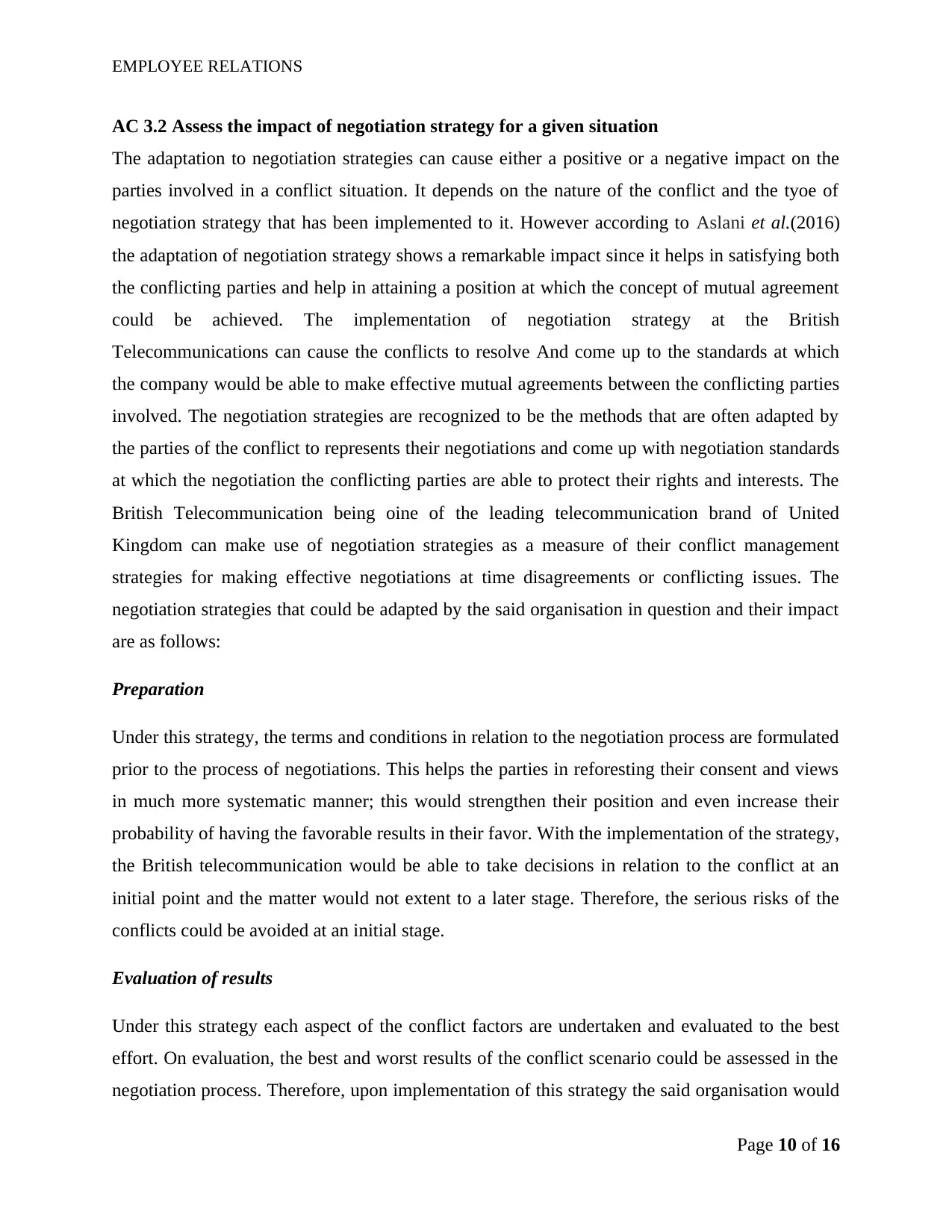
EMPLOYEE RELATIONS
AC 3.2 Assess the impact of negotiation strategy for a given situation
The adaptation to negotiation strategies can cause either a positive or a negative impact on the
parties involved in a conflict situation. It depends on the nature of the conflict and the tyoe of
negotiation strategy that has been implemented to it. However according to Aslani et al.(2016)
the adaptation of negotiation strategy shows a remarkable impact since it helps in satisfying both
the conflicting parties and help in attaining a position at which the concept of mutual agreement
could be achieved. The implementation of negotiation strategy at the British
Telecommunications can cause the conflicts to resolve And come up to the standards at which
the company would be able to make effective mutual agreements between the conflicting parties
involved. The negotiation strategies are recognized to be the methods that are often adapted by
the parties of the conflict to represents their negotiations and come up with negotiation standards
at which the negotiation the conflicting parties are able to protect their rights and interests. The
British Telecommunication being oine of the leading telecommunication brand of United
Kingdom can make use of negotiation strategies as a measure of their conflict management
strategies for making effective negotiations at time disagreements or conflicting issues. The
negotiation strategies that could be adapted by the said organisation in question and their impact
are as follows:
Preparation
Under this strategy, the terms and conditions in relation to the negotiation process are formulated
prior to the process of negotiations. This helps the parties in reforesting their consent and views
in much more systematic manner; this would strengthen their position and even increase their
probability of having the favorable results in their favor. With the implementation of the strategy,
the British telecommunication would be able to take decisions in relation to the conflict at an
initial point and the matter would not extent to a later stage. Therefore, the serious risks of the
conflicts could be avoided at an initial stage.
Evaluation of results
Under this strategy each aspect of the conflict factors are undertaken and evaluated to the best
effort. On evaluation, the best and worst results of the conflict scenario could be assessed in the
negotiation process. Therefore, upon implementation of this strategy the said organisation would
Page 10 of 16
AC 3.2 Assess the impact of negotiation strategy for a given situation
The adaptation to negotiation strategies can cause either a positive or a negative impact on the
parties involved in a conflict situation. It depends on the nature of the conflict and the tyoe of
negotiation strategy that has been implemented to it. However according to Aslani et al.(2016)
the adaptation of negotiation strategy shows a remarkable impact since it helps in satisfying both
the conflicting parties and help in attaining a position at which the concept of mutual agreement
could be achieved. The implementation of negotiation strategy at the British
Telecommunications can cause the conflicts to resolve And come up to the standards at which
the company would be able to make effective mutual agreements between the conflicting parties
involved. The negotiation strategies are recognized to be the methods that are often adapted by
the parties of the conflict to represents their negotiations and come up with negotiation standards
at which the negotiation the conflicting parties are able to protect their rights and interests. The
British Telecommunication being oine of the leading telecommunication brand of United
Kingdom can make use of negotiation strategies as a measure of their conflict management
strategies for making effective negotiations at time disagreements or conflicting issues. The
negotiation strategies that could be adapted by the said organisation in question and their impact
are as follows:
Preparation
Under this strategy, the terms and conditions in relation to the negotiation process are formulated
prior to the process of negotiations. This helps the parties in reforesting their consent and views
in much more systematic manner; this would strengthen their position and even increase their
probability of having the favorable results in their favor. With the implementation of the strategy,
the British telecommunication would be able to take decisions in relation to the conflict at an
initial point and the matter would not extent to a later stage. Therefore, the serious risks of the
conflicts could be avoided at an initial stage.
Evaluation of results
Under this strategy each aspect of the conflict factors are undertaken and evaluated to the best
effort. On evaluation, the best and worst results of the conflict scenario could be assessed in the
negotiation process. Therefore, upon implementation of this strategy the said organisation would
Page 10 of 16
Paraphrase This Document
Need a fresh take? Get an instant paraphrase of this document with our AI Paraphraser
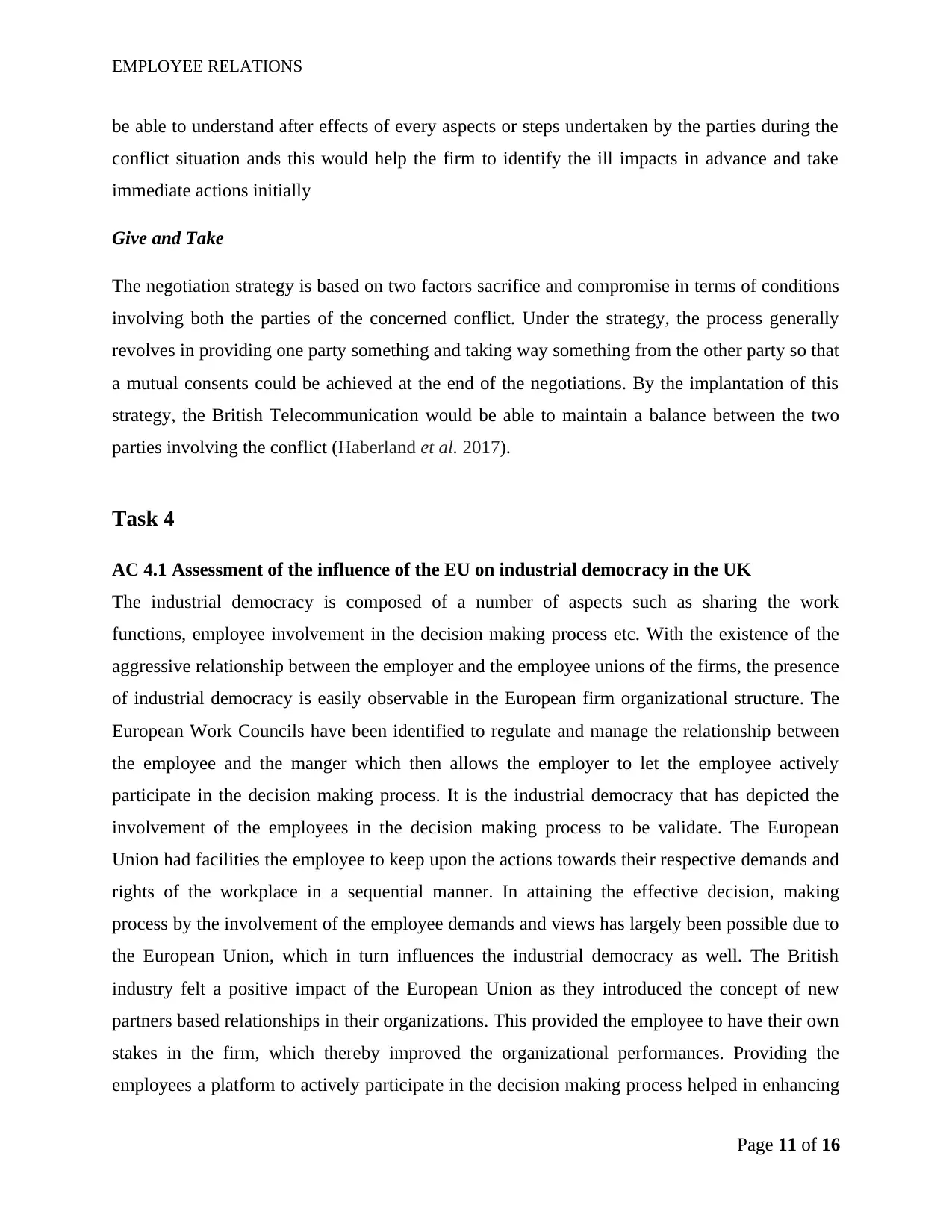
EMPLOYEE RELATIONS
be able to understand after effects of every aspects or steps undertaken by the parties during the
conflict situation ands this would help the firm to identify the ill impacts in advance and take
immediate actions initially
Give and Take
The negotiation strategy is based on two factors sacrifice and compromise in terms of conditions
involving both the parties of the concerned conflict. Under the strategy, the process generally
revolves in providing one party something and taking way something from the other party so that
a mutual consents could be achieved at the end of the negotiations. By the implantation of this
strategy, the British Telecommunication would be able to maintain a balance between the two
parties involving the conflict (Haberland et al. 2017).
Task 4
AC 4.1 Assessment of the influence of the EU on industrial democracy in the UK
The industrial democracy is composed of a number of aspects such as sharing the work
functions, employee involvement in the decision making process etc. With the existence of the
aggressive relationship between the employer and the employee unions of the firms, the presence
of industrial democracy is easily observable in the European firm organizational structure. The
European Work Councils have been identified to regulate and manage the relationship between
the employee and the manger which then allows the employer to let the employee actively
participate in the decision making process. It is the industrial democracy that has depicted the
involvement of the employees in the decision making process to be validate. The European
Union had facilities the employee to keep upon the actions towards their respective demands and
rights of the workplace in a sequential manner. In attaining the effective decision, making
process by the involvement of the employee demands and views has largely been possible due to
the European Union, which in turn influences the industrial democracy as well. The British
industry felt a positive impact of the European Union as they introduced the concept of new
partners based relationships in their organizations. This provided the employee to have their own
stakes in the firm, which thereby improved the organizational performances. Providing the
employees a platform to actively participate in the decision making process helped in enhancing
Page 11 of 16
be able to understand after effects of every aspects or steps undertaken by the parties during the
conflict situation ands this would help the firm to identify the ill impacts in advance and take
immediate actions initially
Give and Take
The negotiation strategy is based on two factors sacrifice and compromise in terms of conditions
involving both the parties of the concerned conflict. Under the strategy, the process generally
revolves in providing one party something and taking way something from the other party so that
a mutual consents could be achieved at the end of the negotiations. By the implantation of this
strategy, the British Telecommunication would be able to maintain a balance between the two
parties involving the conflict (Haberland et al. 2017).
Task 4
AC 4.1 Assessment of the influence of the EU on industrial democracy in the UK
The industrial democracy is composed of a number of aspects such as sharing the work
functions, employee involvement in the decision making process etc. With the existence of the
aggressive relationship between the employer and the employee unions of the firms, the presence
of industrial democracy is easily observable in the European firm organizational structure. The
European Work Councils have been identified to regulate and manage the relationship between
the employee and the manger which then allows the employer to let the employee actively
participate in the decision making process. It is the industrial democracy that has depicted the
involvement of the employees in the decision making process to be validate. The European
Union had facilities the employee to keep upon the actions towards their respective demands and
rights of the workplace in a sequential manner. In attaining the effective decision, making
process by the involvement of the employee demands and views has largely been possible due to
the European Union, which in turn influences the industrial democracy as well. The British
industry felt a positive impact of the European Union as they introduced the concept of new
partners based relationships in their organizations. This provided the employee to have their own
stakes in the firm, which thereby improved the organizational performances. Providing the
employees a platform to actively participate in the decision making process helped in enhancing
Page 11 of 16
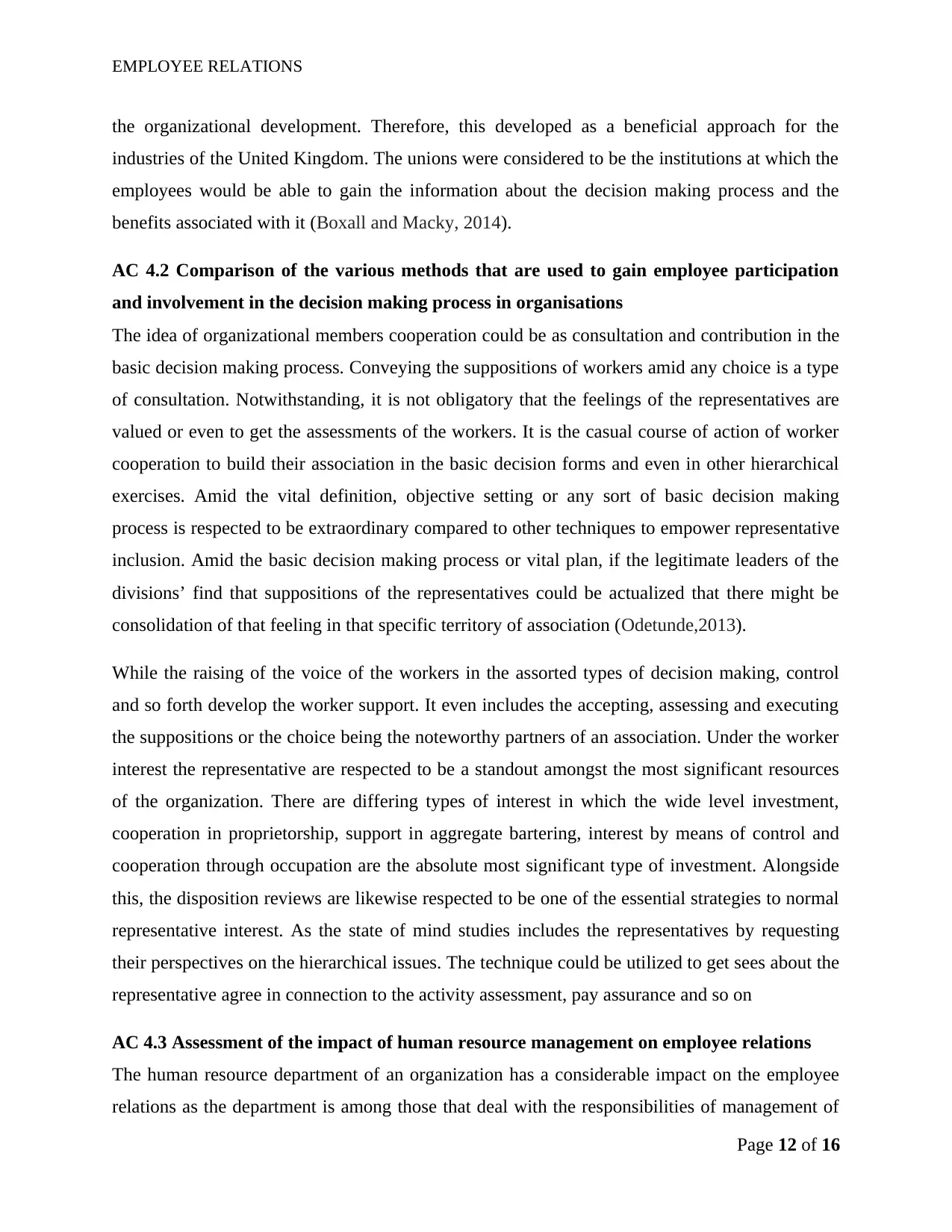
EMPLOYEE RELATIONS
the organizational development. Therefore, this developed as a beneficial approach for the
industries of the United Kingdom. The unions were considered to be the institutions at which the
employees would be able to gain the information about the decision making process and the
benefits associated with it (Boxall and Macky, 2014).
AC 4.2 Comparison of the various methods that are used to gain employee participation
and involvement in the decision making process in organisations
The idea of organizational members cooperation could be as consultation and contribution in the
basic decision making process. Conveying the suppositions of workers amid any choice is a type
of consultation. Notwithstanding, it is not obligatory that the feelings of the representatives are
valued or even to get the assessments of the workers. It is the casual course of action of worker
cooperation to build their association in the basic decision forms and even in other hierarchical
exercises. Amid the vital definition, objective setting or any sort of basic decision making
process is respected to be extraordinary compared to other techniques to empower representative
inclusion. Amid the basic decision making process or vital plan, if the legitimate leaders of the
divisions’ find that suppositions of the representatives could be actualized that there might be
consolidation of that feeling in that specific territory of association (Odetunde,2013).
While the raising of the voice of the workers in the assorted types of decision making, control
and so forth develop the worker support. It even includes the accepting, assessing and executing
the suppositions or the choice being the noteworthy partners of an association. Under the worker
interest the representative are respected to be a standout amongst the most significant resources
of the organization. There are differing types of interest in which the wide level investment,
cooperation in proprietorship, support in aggregate bartering, interest by means of control and
cooperation through occupation are the absolute most significant type of investment. Alongside
this, the disposition reviews are likewise respected to be one of the essential strategies to normal
representative interest. As the state of mind studies includes the representatives by requesting
their perspectives on the hierarchical issues. The technique could be utilized to get sees about the
representative agree in connection to the activity assessment, pay assurance and so on
AC 4.3 Assessment of the impact of human resource management on employee relations
The human resource department of an organization has a considerable impact on the employee
relations as the department is among those that deal with the responsibilities of management of
Page 12 of 16
the organizational development. Therefore, this developed as a beneficial approach for the
industries of the United Kingdom. The unions were considered to be the institutions at which the
employees would be able to gain the information about the decision making process and the
benefits associated with it (Boxall and Macky, 2014).
AC 4.2 Comparison of the various methods that are used to gain employee participation
and involvement in the decision making process in organisations
The idea of organizational members cooperation could be as consultation and contribution in the
basic decision making process. Conveying the suppositions of workers amid any choice is a type
of consultation. Notwithstanding, it is not obligatory that the feelings of the representatives are
valued or even to get the assessments of the workers. It is the casual course of action of worker
cooperation to build their association in the basic decision forms and even in other hierarchical
exercises. Amid the vital definition, objective setting or any sort of basic decision making
process is respected to be extraordinary compared to other techniques to empower representative
inclusion. Amid the basic decision making process or vital plan, if the legitimate leaders of the
divisions’ find that suppositions of the representatives could be actualized that there might be
consolidation of that feeling in that specific territory of association (Odetunde,2013).
While the raising of the voice of the workers in the assorted types of decision making, control
and so forth develop the worker support. It even includes the accepting, assessing and executing
the suppositions or the choice being the noteworthy partners of an association. Under the worker
interest the representative are respected to be a standout amongst the most significant resources
of the organization. There are differing types of interest in which the wide level investment,
cooperation in proprietorship, support in aggregate bartering, interest by means of control and
cooperation through occupation are the absolute most significant type of investment. Alongside
this, the disposition reviews are likewise respected to be one of the essential strategies to normal
representative interest. As the state of mind studies includes the representatives by requesting
their perspectives on the hierarchical issues. The technique could be utilized to get sees about the
representative agree in connection to the activity assessment, pay assurance and so on
AC 4.3 Assessment of the impact of human resource management on employee relations
The human resource department of an organization has a considerable impact on the employee
relations as the department is among those that deal with the responsibilities of management of
Page 12 of 16
⊘ This is a preview!⊘
Do you want full access?
Subscribe today to unlock all pages.

Trusted by 1+ million students worldwide
1 out of 16
Related Documents
Your All-in-One AI-Powered Toolkit for Academic Success.
+13062052269
info@desklib.com
Available 24*7 on WhatsApp / Email
![[object Object]](/_next/static/media/star-bottom.7253800d.svg)
Unlock your academic potential
Copyright © 2020–2025 A2Z Services. All Rights Reserved. Developed and managed by ZUCOL.





